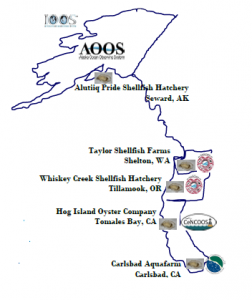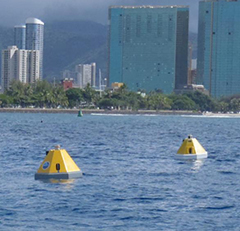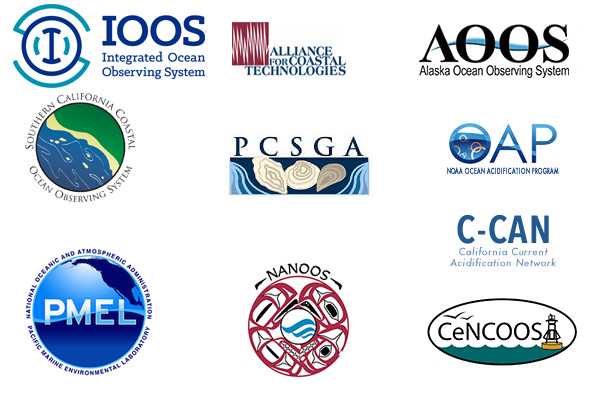Shellfish play a vital role in the environment, culture, and economy in many U.S. coastal communities. The shellfish aquaculture community is the largest segment of marine aquaculture in the United States. Several thousand small farms nationwide harvest over $600 million worth of sustainable shellfish while providing tens of thousands of jobs in rural coastal communities.
In 2005, production at some Pacific Northwest oyster hatcheries began declining at an alarming rate, posing severe economic impact and challenging a way of life held by shellfish growers for over 130 years. By 2008, oyster losses at the largest oyster hatchery on the West Coast reached 80 percent.
In 2010, NOAA scientists determined corrosive water was killing the oyster larvae. Corrosive water enters the bays and inlets, where the Pacific Northwest hatcheries operate, at certain times of the year—usually in summer, and specifically on days when winds from the northwest caused upwelling of deeper water, which is more acidic than surface water.
Ocean acidification refers to the on-going change in the chemistry of the ocean caused primarily by the ocean’s absorption of carbon dioxide from the atmosphere. The ocean generally has an alkaline pH, but as the ocean continues to absorb carbon dioxide it has become more acidic. As the ocean becomes more acidic, carbonite based minerals such as calcium carbonate, important for shellfish development and survival, are reduced.
Shellfish farmers are increasingly dependent on real-time monitoring to know when corrosive waters may challenge the development of shellfish. Without data from monitoring equipment, shellfish growers have no way to assess how the chemical make-up of the water will affect shellfish productivity, thus growers cannot adapt their aquaculture practices to minimize impacts from ocean acidification.

Locations of Burkolator stations in Alaska, Washington, Oregon, and California. Credit: SCCOOS. Click on graphic for larger view.
In 2013, U.S. IOOS’ Ocean Technology Transition Project, in collaboration with NOAA’s Ocean Acidification Program, awarded a $604,420 grant to fund five activities across the West Coast, Alaska, and Hawaii to support ocean acidification sensor development and applications to provide information about ocean acidification for protection of the shellfish industry. Partners in this effort include five U.S. IOOS Regional Associations (RAs) – Northwest Association of Networked Ocean Observing Systems (NANOOS), Central and Northern California Ocean Observing System (CeNCOOS), Southern California Coastal Ocean Observing System (SCCOOS), Alaska Ocean Observing System (AOOS), Pacific Islands Ocean Observing System (PacIOOS) -- and NOAA’s Pacific Marine Environmental Laboratory (PMEL).
Project Details
The following is a summary and status for each of the five activities:
- Develop an application of state of the art monitoring technologies for shellfish hatcheries and growers in Washington and Oregon. The focus is to develop an open water, nearshore mooring (build and deploy two prototypes) to measure relevant ocean acidification parameters throughout the water column and report in near real time. The challenge is developing a mooring that can withstand the temperature extremes which exist in nearshore, shallow water temperate systems. Monitoring equipment prototypes have been deployed at Dabob and Twanoh, WA at locations relevant for local shellfish industries. A third deployment at the Carr Inlet, WA is expected by the end of 2014. The prototype mooring, composed of sensors both commercially available and in development, will be available for broad scale distribution once tested.
- Application and testing of new observing technologies for ocean acidification observing on deep water moorings off Oregon and Washington. Advanced ocean acidification (NOAA/PMEL MAPCO2, SeapHOx, pH, and O2) measurement systems have been installed on the NH10 and La Push buoys in WA. These moorings will act as sensor test beds and will be made available to XPrize contestants (and others upon request) as locations for testing the new pH2 sensors that XPrize is targeting.
- Testing of beta aragonite saturation state prototype monitoring equipment (pCO2 and dissolved inorganic carbon, or DIC) In support of the West Coast shellfish industry; AOOS, NANOOS (link to),CeNCOOS, and SCCOOS added Ocean Acidification monitoring to their ongoing observations of the coastal ocean. The beta aragonite saturation state prototype (also known as the Burkolator) developed by Burke Hales at Oregon State University was deployed at three new locations in 2014: Carlsbad Aquafarm and Hog Island Oyster Company, both in California, and one site in Southeastern Alaska, the Alutiiq Pride Shellfish Hatchery. This supplemented existing equipment located at Whiskey Creek Hatchery in Oregon and at Taylor Shellfish Hatchery in Washington State.
- Open water testing off Hawaii of the first remotely deployable, prototype Dissolved Inorganic Carbon (DIC) analyzer, developed by PMEL. Working with PacIOOS, PMEL researchers deployed a new buoy and DIC next to the PacIOOS water quality buoy off Kewalo on the south shore of O'ahu in October 2013. The project is part of a University of Hawai'i’s year-long field evaluation of the automated DIC sensor. The goal of the project is to transition new ocean acidification sensor technology to support both shellfish industry monitoring needs in the Pacific Northwest, where ocean acidification problems have already manifested, as well as on coral reefs, which are in potential danger from continued ocean acidification. The project also aims to develop the technical workforce's capacity to deploy and utilize these sensors.
- Deploy IOOS Pacific Regional Ocean Acidification Portal. A significant amount of data in support of ocean acidification is being produced as a result of this and previously funded projects. The IOOS Pacific Region Ocean Acidification Data Portal was launched in November 2014, and can be accessed at www.ipacoa.org. The portal provides ocean acidification relevant data from partners in industry, government, and academia who are involved with the IOOS regional ocean observing systems in the Pacific region: Alaska (AOOS), Washington and Oregon (NANOOS), Central and Northern California (CeNCOOS), Southern California (SCCOOS), and the Pacific Islands (PacIOOS).
For more information about this project contact Dr. Jan Newton.For more information about IOOS’ Ocean Technology Transition Project, please contact Tiffany Vance, Project Manager.
 Official websites use .gov
A .gov website belongs to an official government organization in the United States.
Official websites use .gov
A .gov website belongs to an official government organization in the United States.
 Secure .gov websites use HTTPS
A lock or https:// means you’ve safely connected to the .gov website. Share sensitive information only on official, secure websites.
Secure .gov websites use HTTPS
A lock or https:// means you’ve safely connected to the .gov website. Share sensitive information only on official, secure websites.


